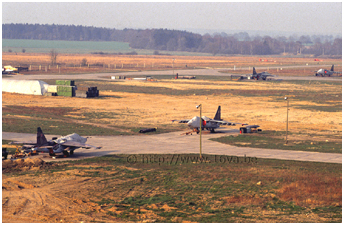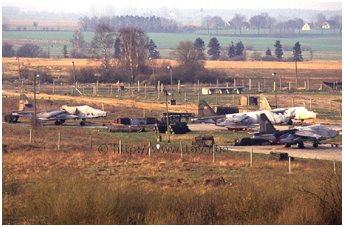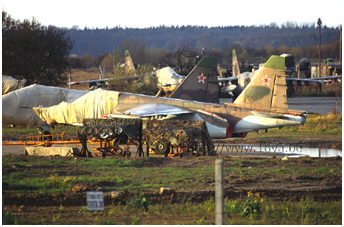The Red Army was transformed into the Soviet Army in 1946. The latter has given way to the Russian Army in 1991.
On 3 November 1992 after a visit to the helicopters "Hip" and "Hind" of the former East German Army at Basepohl, we decided to drive to the base nearby at Tutow, which hosted the Su-25 "Frogfoot" of the 368.OShAP. After receiving confirmation from the German air traffic controllers that Tutow was active, we rapidly departed. At the exit of the village of Demmin, we passed along a sport center with enormous martial statutes that were overlooking sportsmen warming themselves. A warm winter sun heated the Pomeranian countryside. A few kilometers before the base perimeter, we saw along the road the landing lights on poles, which were lighted. "A good sign, the landing lights are lit", Hugo said. Maybe we would, after several unfruitful visits, photograph our first "frog's legs" of that "Shturmovik" regiment which arrived in Germany in December 1988 after two years of combat against the Afghan Moudjahidin. The excitement grew, the only thing left to do was checking that aircraft were actually parked on the flightline.
After crossing the runway axis and rapidly driving through the Krückow hamlet, we drove on the main road of the Tutow village. Hugo who already knew the place, indicated a side road that lead to the main gate. Before reaching it, we abruptly turned left, then right and continued our way crossing a railroad until we reached a dead end. Before us, the base, dominated by large grey silos, relics of a former East German agricultural cooperative - the very ones which, on 12 April 1990 were accidentally hit by a salvo of 57 mm rockets fired from a dangerously distracted Su-25 on the ground.
 We stopped our car in view of the fence. Everything seemed calm. 100 meters away, the silhouettes of the "Frogfoots"
covered with tarpaulins were visible. We decided to move along the double barbed wire fence with discretion, hiding behind
an embankment. Small warning plates with Cyrillic characters painted on them reminded to the curious that this was a military
zone off limits. Finally, we climbed on a small hill to contemplate Tutow. But we were disappointed: there was hardly any
activities going on. At some distance, a group of soldiers seemed to be training close to a wooden shelter and some
mechanics were discussing near a low building. Slowly, we approached the fence in open terrain and we took some atmosphere
snapshots. The "Frogfoot" were waiting there at a few tens of meters, parked and more visible than ever before. The
Russians, in anticipation of the coming evacuation, had already removed the protective earth mounds of the dispersals that
were protecting the aircraft from the observers and the aerial attacks. Alerted by our intrusion a guard with a red armband
riding a bicycle arrived quickly, and gave us the order to go away.
We stopped our car in view of the fence. Everything seemed calm. 100 meters away, the silhouettes of the "Frogfoots"
covered with tarpaulins were visible. We decided to move along the double barbed wire fence with discretion, hiding behind
an embankment. Small warning plates with Cyrillic characters painted on them reminded to the curious that this was a military
zone off limits. Finally, we climbed on a small hill to contemplate Tutow. But we were disappointed: there was hardly any
activities going on. At some distance, a group of soldiers seemed to be training close to a wooden shelter and some
mechanics were discussing near a low building. Slowly, we approached the fence in open terrain and we took some atmosphere
snapshots. The "Frogfoot" were waiting there at a few tens of meters, parked and more visible than ever before. The
Russians, in anticipation of the coming evacuation, had already removed the protective earth mounds of the dispersals that
were protecting the aircraft from the observers and the aerial attacks. Alerted by our intrusion a guard with a red armband
riding a bicycle arrived quickly, and gave us the order to go away.
 As it seemed that nothing was going to happen anyway, we decided to head back to our car. Suddenly we heard shouts. Two Russian soldiers with
Kalachnikov machine guns slung over their shoulders, were running towards us while awkwardly trying to fasten their belts and keep their chapka
on their heads at the same time! What did they want? Upon reaching our car we quickly packed our photo material and waited.
It was too late to move anyway. More than once during our reconnaissance and photographic strolls along the fences of
Russian bases, we were approached by soldiers trying to trade cigarettes, vodka or caviar for DM. But this time, things
looked differently. Before we could make the slightest gesture, they posted themselves behind our car and slammed the breech
of their guns. Something was wrong. Above all, we had to remain calm! Now, a group of almost 20 soldiers with arms arrived
aboard an Ural truck and walked through the fence in our direction. Their commander, a NCO, walked towards us and "invited"
us in Russian and with gestures to follow him inside the base. That was not an acceptable option. As long as we stayed
outside the base, we were on the grounds of the Federal Republic of Germany and - is it necessary to mention - we wanted
to stay there. Who could prove afterwards that we were not caught inside the base? We spoke some words in German
requesting the presence of the German Polizei, however nobody seemed to understand us. We categorically refused to
move, which confused the NCO and he precipitously returned to the base. We were surrounded by now. How did we end up in this
mess? Now, an UAZ-469 jeep arrived and parked along the fence. This time, an officer accompanied the NCO. The officer
gestured us again to come inside the base, however we resisted with a categorical "Niet" and repeated our demands to see
the German police. Long minutes went by in a total mutual incomprehension. The tension grew; would they use force?
As it seemed that nothing was going to happen anyway, we decided to head back to our car. Suddenly we heard shouts. Two Russian soldiers with
Kalachnikov machine guns slung over their shoulders, were running towards us while awkwardly trying to fasten their belts and keep their chapka
on their heads at the same time! What did they want? Upon reaching our car we quickly packed our photo material and waited.
It was too late to move anyway. More than once during our reconnaissance and photographic strolls along the fences of
Russian bases, we were approached by soldiers trying to trade cigarettes, vodka or caviar for DM. But this time, things
looked differently. Before we could make the slightest gesture, they posted themselves behind our car and slammed the breech
of their guns. Something was wrong. Above all, we had to remain calm! Now, a group of almost 20 soldiers with arms arrived
aboard an Ural truck and walked through the fence in our direction. Their commander, a NCO, walked towards us and "invited"
us in Russian and with gestures to follow him inside the base. That was not an acceptable option. As long as we stayed
outside the base, we were on the grounds of the Federal Republic of Germany and - is it necessary to mention - we wanted
to stay there. Who could prove afterwards that we were not caught inside the base? We spoke some words in German
requesting the presence of the German Polizei, however nobody seemed to understand us. We categorically refused to
move, which confused the NCO and he precipitously returned to the base. We were surrounded by now. How did we end up in this
mess? Now, an UAZ-469 jeep arrived and parked along the fence. This time, an officer accompanied the NCO. The officer
gestured us again to come inside the base, however we resisted with a categorical "Niet" and repeated our demands to see
the German police. Long minutes went by in a total mutual incomprehension. The tension grew; would they use force?
 We heard the sound of an engine; would this finally be the German police arriving? No, just another UAZ-469 which came
from the direction of the village. It was decorated with a red stripe and a small flag. The jeep rapidly stopped and two
persons went out, an officer and a young civilian girl. The size of the officer's cap and the length of his coat - the same
style you see at the annual parade on 1st May in Moscow - indicated that we were dealing with an important man.
Most of the soldiers present discretely straightened their uniforms. With two or three short questions he analyzed the
situation. Then, with the help of the young Russian civilian girl who talked a little German, he presented himself as the
commander of the airbase of Tutow (1)
in which an article about the open day at Finow in May of the same year, had been published. But another publication
and demanded an explanation about our presence near the fences of his base. We produced
some aviation magazines: one of them was the "Air Action" issue (2)
particularly drew the attention of our interrogators: an "AirForces Monthly" issue
(3), where one could see a picture of the Su-25 from Tutow taken
from the silos and an overview of all active and reserve bases of the 16.VA, as well as the different aircraft types on
strength. The next question was very clear: "Niederland?" What a shame, they took us for Dutch aircraft spotters! After
a few minutes of useless palaver we finally agree to follow the commander inside the base. Richard and Hugo climbed in our
car accompanied by two armed men, while Jean-Luc was requested to climb onboard the jeep. When the young interpreter got
into the jeep, she stumbled. Jean-Luc and the commander catched her together at the same time. Smiles. The atmosphere
relaxed a little bit. Crossing the main gate, and here we were in the lair of the Russian bear, trapped by our
unconsciousness. It was now 6 pm. One hour had already passed since this little comedy had started. But how did we end up
in this mess?
We heard the sound of an engine; would this finally be the German police arriving? No, just another UAZ-469 which came
from the direction of the village. It was decorated with a red stripe and a small flag. The jeep rapidly stopped and two
persons went out, an officer and a young civilian girl. The size of the officer's cap and the length of his coat - the same
style you see at the annual parade on 1st May in Moscow - indicated that we were dealing with an important man.
Most of the soldiers present discretely straightened their uniforms. With two or three short questions he analyzed the
situation. Then, with the help of the young Russian civilian girl who talked a little German, he presented himself as the
commander of the airbase of Tutow (1)
in which an article about the open day at Finow in May of the same year, had been published. But another publication
and demanded an explanation about our presence near the fences of his base. We produced
some aviation magazines: one of them was the "Air Action" issue (2)
particularly drew the attention of our interrogators: an "AirForces Monthly" issue
(3), where one could see a picture of the Su-25 from Tutow taken
from the silos and an overview of all active and reserve bases of the 16.VA, as well as the different aircraft types on
strength. The next question was very clear: "Niederland?" What a shame, they took us for Dutch aircraft spotters! After
a few minutes of useless palaver we finally agree to follow the commander inside the base. Richard and Hugo climbed in our
car accompanied by two armed men, while Jean-Luc was requested to climb onboard the jeep. When the young interpreter got
into the jeep, she stumbled. Jean-Luc and the commander catched her together at the same time. Smiles. The atmosphere
relaxed a little bit. Crossing the main gate, and here we were in the lair of the Russian bear, trapped by our
unconsciousness. It was now 6 pm. One hour had already passed since this little comedy had started. But how did we end up
in this mess?
notes
(1) Colonel Nikolai Ivanovich Tankushin.
(2) GUHL (J.-M.), Une "JPO" chez les Russes, Flugtag Eberswalde 1992, in Air Action, n°35 - Juin/Juillet/Août 1992.
(3) WILLEMSEN (F.), Red stars over Germany , in AirForces Monthly, nr.46 - January 1992.
 |
Prisoners of the "Red Army" > Part 2 |
 |
Plan du site - Sitemap |  |
